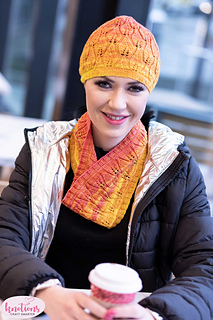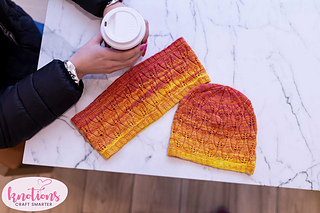patterns > Knotions Magazine >  Knotions, March 2020 and 1 more...
Knotions, March 2020 and 1 more...
> Spectral Analysis Cowl












Spectral Analysis Cowl
Did You Know?
Have you ever wondered how scientists know what chemical elements a star, supernova or a whole galaxy is made of? As you can imagine, it is terribly complicated. But the very basics for it is a super simple experiment that students learn about in their 3rd semester called spectral analysis.
How Does it Work?
Elements can be identified by the color they give to a flame. The wavelength of the color identifies the element, and the intensity gives away the amount. Sodium, for example, shows two very distinct yellow lines.
Even the names of some elements refer to spectral analysis. Rubidium shows a dark red line and its name comes from Latin rubidus meaning dark red. Cesium comes from the Latin word for sky blue, again after the color of its spectral line.
Spectral analysis is an experiment that I remember fondly to this day. It was easy, fun and—most of all—it worked! It inspired the beautiful candle flame pattern on this cowl.
Yarn
Unique Sheep Verve (100% superwash merino wool; 400 yds 366 m/100g): Erin’s Dream, 1 (1, 2) skeins.
Thanks to the Unique Sheep for donating the yarn and to Carol for knitting the sample!
Needles
Size US1.5 (2.5mm) needles 24″ (60cm) circulars
Or size needed to obtain gauge
Size US000 (1.75mm) needles 24″ (60cm) circulars
Or several sizes smaller than needed to obtain gauge
Gauge
30 sts and 38 rows = 4″ 10cm in St st
28 sts and 40 rows = 4″ 10cm in patt after blocking
Size
Size S (M, L)
27 (47.25, 59)” 68.5 (120, 150) cm circumference and 5.5” 14cm high
Notions
Tapestry needle, 1 stitch marker (for BOR)
1354 projects
stashed
1933 times
- First published: February 2020
- Page created: February 28, 2020
- Last updated: February 28, 2020 …
- visits in the last 24 hours
- visitors right now




